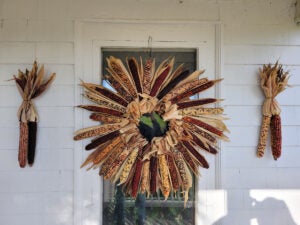Growing up my dad grew a huge garden every summer. It was so big that it could have been considered a second job.
He would come home from the farm and go straight to the garden. Not only did the garden feed our household of seven, but family members would often come to pick veggies for themselves as well.
We canned tomatoes and salsa, frozen green beans, stored potatoes and turnips, but one of my favorite items from the garden was the mini popcorn.
The small, colorful ears produced tiny kernels, which when popped, produced a mini popcorn. The popcorn tastes the same as regular sized popcorn, while also being significantly cuter.
These colorful varieties of corn, often referred to as Indian Corn, are fun to grow.
Richard Lawson grows this variety of corn, whose history is much richer than the mini popcorn I enjoy.
Lawson’s father, Dick Lawson Jr., explained that early 1960s, an American Indian neighbor who was stepping away from farming gave his family some flint corn seeds. Dick Lawson’s mother used some for decoration, and the rest went to feed their herd of dairy cows.
“Over the years” Dick Lawson said, “we crossed it with other Indian corn and selected the biggest and most colorful ears for seed.” His mother would give out some of the beautiful ears to neighbors and friends as decoration — and it didn’t take long to be noticed by others in the community.

In the mid- to late-’60s, a local farm stand bought some ears to sell, and by 1987, his mother was drying and selling over 600 bunches a year.
Dick Lawson and his wife, Laura, continue to grow the corn today to sell locally, use for decoration, animal feed, grind into cornmeal for baking, and even pop for popcorn.
This beautiful heirloom corn has been passed down through three generations since first given to the Lawson family, and will surely continue to grow with them.
Other varieties, too, are equally rich with history — many people enjoy growing heirlooms for their bold taste, unique flavors, and, sometimes, just their beauty.
Ted Chewning, from Colleton County, South Carolina, has made a name for himself growing heirloom crops.
Chewning became well known in heirloom circles because of his success at reviving Jimmy Red Corn, an heirloom variety so close to extinction that Chewning had — what was then known to be — the last two ears of Jimmy Red Corn in his hands.
Growing up, Chewning spent most of his time on his family’s dairy farm. Cultivating heirloom crops wasn’t always his passion; as a teenager Chewning worked for the U.S. Forest Service growing pine trees for the government.
Eventually he took to gardening, mostly to embrace a bountiful supply of tomatoes, peppers, and other veggies — it was a typical backyard garden coupled with chickens and pigs that he sold as meat to local restaurants.
In that time, Chewning’s love for gardening grew, and his love for heirloom varieties followed naturally.
Chewning explained that the story of Jimmy Red Corn goes back about 25 years ago when a friend who “had a feed and seed store, a little place called Red Top,” came by with the last two ears of Jimmy Red Corn. The store owner was saving the ears for Chewning, knowing he could get a good crop growing.
At this point, you may be wondering where exactly did these last two ears come from?
Chewning says that there was a man who grew Jimmy Red Corn in the area but had passed away before harvesting that year’s crop. Chewning’s friend from the feed and seed store brought the ears to Chewning specifically hoping that he would keep the corn variety alive.
According to Chewning, the man who left behind the last of the Jimmy Red Corn was the grandson of a Georgian man who came to South Carolina to use the variety in moonshine. The corn’s high oil content enhances the production and flavor of the moonshine … or so we are told.
Chewning took those final ears and chose the best seeds to plant in a secluded place on his farm, ensuring that there was no cross pollination. Season after season, he reserved the best kernels to grow. After growing it for 20 years, Chewning said that Glenn Roberts, founder of milling company Anson Mills, was driving by his place with his daughter when he saw Jimmy Red Corn for the first time. he saw opportunity.
Jimmy Red Corn then became known for its excellent alcohol and pink colored and nutty flavored grits. High Wire Distilling in Charleston South Carolina, jumped on the opportunity to make bourbon from the corn, which helped it explode in popularity.
Growing heirloom crops such as Jimmy Red Corn is a fun, yet challenging hobby. Chewning grows other heirloom crops such as Sea Island White Flint corn, cow peas, and a small sweet watermelon that used to be mixed into corn fields to help keep the weeds down, while also producing a delicious melon.
Chewning says that the most rewarding part of growing these beautiful and historic crops is watching them grow.
“It’s a long time between when you put your seed in the ground to when you harvest,” he said. “You really don’t have anything to do but to watch it grow!”
Chewning prefers to grow his crops in a traditional and organic manner, which he says makes watching the crops grow even more satisfying.
He wants other seed savers to remember that heirloom varieties won’t produce big crops like modern hybrid varieties, but what they lack in quantity, he says they will make up for in quality and flavor.
Today, Chewning continues to grow 12 to 15 acres of crops, as well as other plants, such as Japanese Maples. Although we won’t reveal his age, Chewning said, “I’m getting older, it’s time to relax and grow something easy!”
Saving seeds is widely seen as a great hobby to keep traditional crops alive. The Farmer’s Almanac has a thorough guide with tips and tricks on seed saving and growing heirloom varieties.
With many hybrid and genetically engineered crops gaining popularity in commercial settings, it becomes important for gardeners and niche growers to cultivate heirloom varieties.
Jimmy Red Corn, for example, is resistant to wind because it roots differently than your typical field corn or sweet corn.
Crops that have been growing for hundreds of years have overcome weather events, pests and funguses, making their genes important to modern day production. South Carolina’s Clemson University has a Crop Improvement Association that works with the U.S. Department of Agriculture to save seeds, conduct research, and educate the public — and they sell seeds as well.
Elizabeth Maslyn is a born-and-raised dairy farmer from Upstate New York. Her passion for agriculture has driven her to share the stories of farmers with all consumers, and promote agriculture in everything she does. She works hard to increase food literacy in her community, and wants to share the stories of her local farmers.



